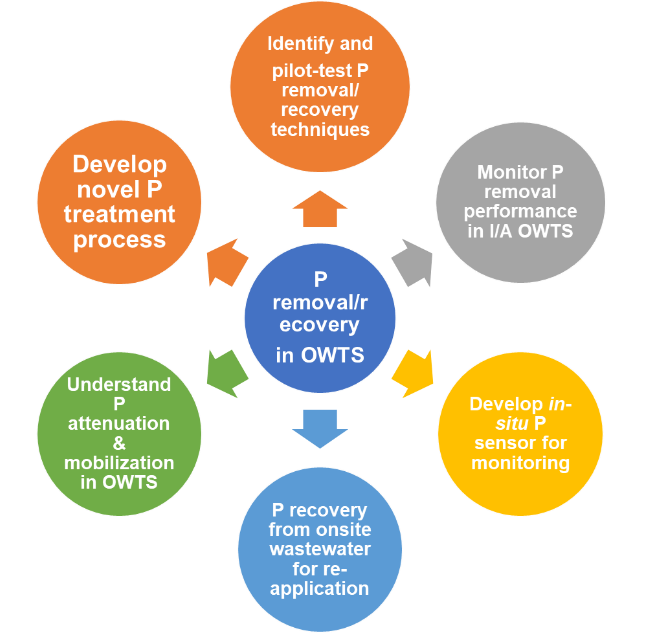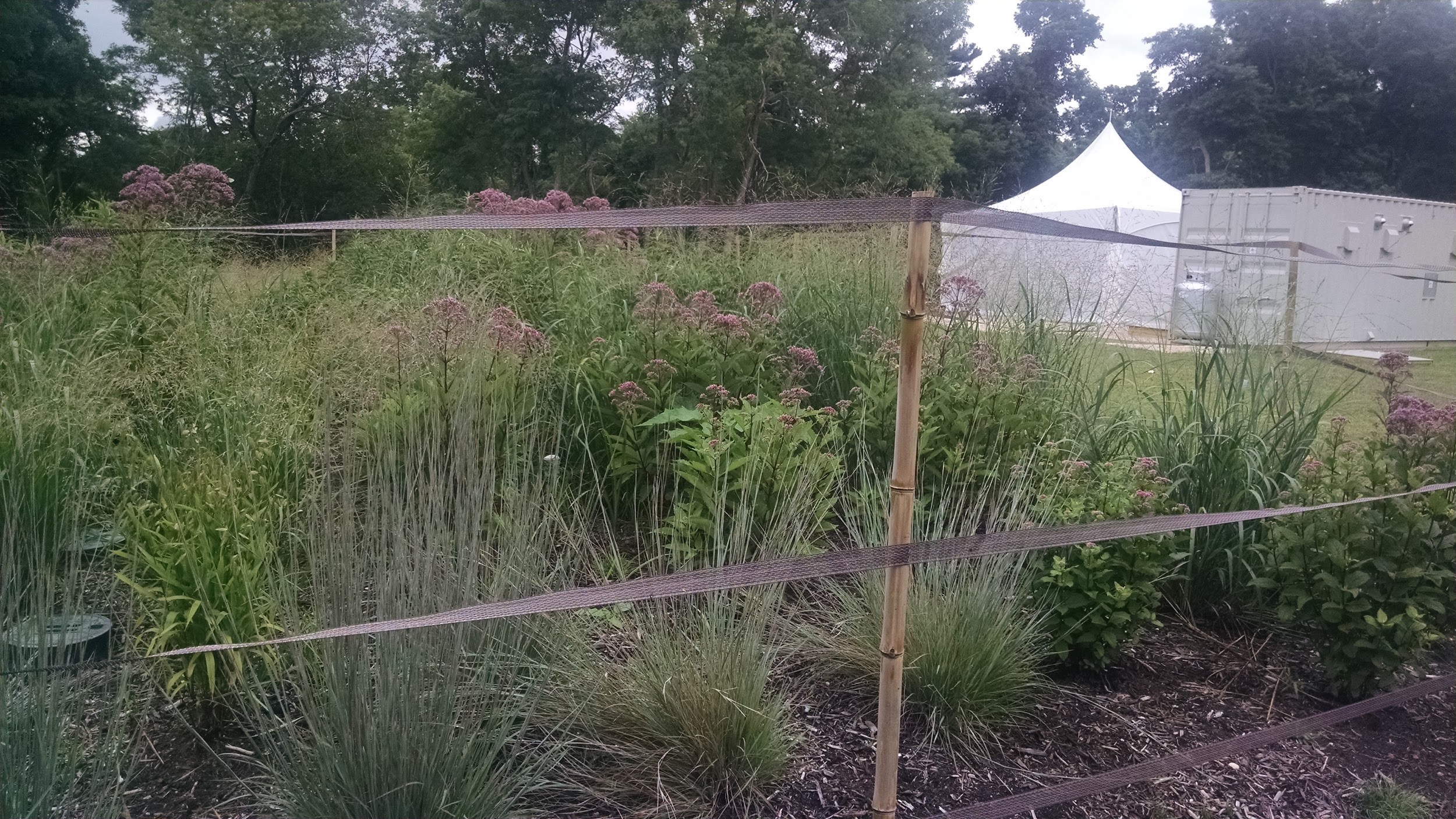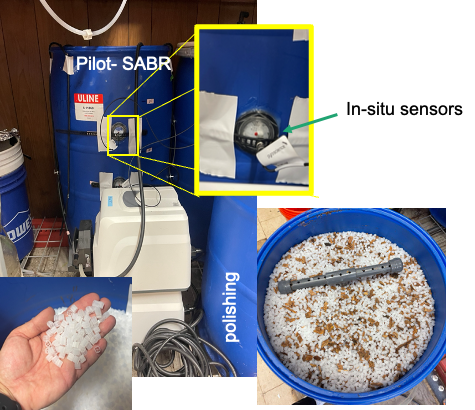Onsite Wastewater Treatment Systems
The goal of the NYS Center for Clean Water Technology is to develop next generation approaches for handling household wastewater that are more efficient at removing nitrogen and other contaminants, less expensive, easier to operate, and smaller in size. While our primary focus is on solving the nitrogen issue in Suffolk County, the solutions developed by the Center will be applicable to other parts of the United States and globally.
For inquiries related to the Center's wastewater research please contact Dr. Stuart Waugh, Senior Research Scientist.
Nitrogen Removing Biofilters (NRBs)
Innovations in onsite treatment of wastewater have produced biofilters designed to take advantage of naturally occurring soil microbes to achieve significant nitrogen removal by nitrification of influent nitrogen and subsequent denitrification of nitrate. Such nitrogen removing biofilters (NRBs) generally consist of a nitrifying sand layer placed over a denitrifying mix of sand and lignocellulose. Since NRBs are passive systems in which water flows by gravity, are constructed with locally available material, and do not require aeration, installation, operation and maintenance costs are minimized. The Center has installed three pilot systems at the Massachusetts Alternative Septic System Test Center (MASSTC) based on variations of NRB technology all of which have achieved ~ 90% reduction of TN in the final effluent since their installation in the Fall of 2016. NRBs also provide significant attenuation of pathogens, pharmaceuticals, and personal care products.
Nitrogen Removing Biofilters Fact Sheet
FlexTreat Biosystem™
The Center has developed and received a US Patent for a unique onsite wastewater treatment system, trademarked as FlexTreat Biofilter™. The system has proven to reduce total nitrogen concentrations to below ten mg/L in a similar footprint and cost as commercially available I/A systems. The patented process uses an attached growth media to achieve nitrification and denitrification. Input variables such as hydraulic loading, oxygen requirements, and recycle ratio, provided via a graphical user interface, are used by the operations and maintenance service provider to optimize performance. The nitrification media is a propriety blend of media that enhances performance at high loading rates. The denitrification chamber uses woodchips as a carbon source and media for denitrifying bacteria to dominate the anoxic biological environment. The Center has constructed and is monitoring a full-scale prototype currently installed at the WRIF which will serve to inform the design of future systems to be installed within a residential setting.
Phosphorus Removal & Recovery
 Removal of phosphorus (P) from onsite wastewater is vital when residences are near
freshwater rivers or lakes, or where fractured bedrock can channel nutrients quickly
to groundwater and surface water. Successful removal of P from septic tank effluent
(STE) is critical to minimize nutrients loading to waterbodies. The Center team aims
to develop affordable, reliable, and effective onsite wastewater treatment technologies
to remove P from wastewater, groundwater, and surface waters utilizing multiple approaches
including adsorption, precipitation reactions and microbial uptake, while concurrently
evaluating the performance and function of P removing OWTS. The Center is also developing
practical, cost-effective methods of P recovery and re-use for agricultural or other
applications. The current focus of the research and development activities include:
Removal of phosphorus (P) from onsite wastewater is vital when residences are near
freshwater rivers or lakes, or where fractured bedrock can channel nutrients quickly
to groundwater and surface water. Successful removal of P from septic tank effluent
(STE) is critical to minimize nutrients loading to waterbodies. The Center team aims
to develop affordable, reliable, and effective onsite wastewater treatment technologies
to remove P from wastewater, groundwater, and surface waters utilizing multiple approaches
including adsorption, precipitation reactions and microbial uptake, while concurrently
evaluating the performance and function of P removing OWTS. The Center is also developing
practical, cost-effective methods of P recovery and re-use for agricultural or other
applications. The current focus of the research and development activities include:
- Evaluate P removal performance by current onsite wastewater treatment systems, such as NRBs and other I/A systems.
- Investigate P attenuation and mobilization mechanisms in current OWTSs and the surrounding soils.
- Evaluate and identify the optimal commercially available P removal technologies for onsite wastewater treatment.
- Research on natural-based materials for P removal and recovery from onsite wastewater and develop modular-based filtration system for implementation.
- Develop in-situ P sensors that could be used to monitor P removal performance in OWTSs.
For inquires related to phosphorus removal and recovery technologies of the center’s research, contact Dr. Xinwei Mao, Associate/Research Director for the Phosphorus program.
Constructed Wetlands
 Constructed wetlands are engineered systems planted with native wetland species that
remove pollutants from water through natural biological, chemical and physical processes.
Water flows vertically or horizontally through a porous medium and are subject to
treatment by passage through the media and plant roots which support sites for microbial
activity. These systems are less expensive to construct and can be more effective
at treating contaminants than traditional systems used for wastewater treatment. The
Center has installed experimental wetlands systems collaboratively on Long Island
and at MASSTC.
Constructed wetlands are engineered systems planted with native wetland species that
remove pollutants from water through natural biological, chemical and physical processes.
Water flows vertically or horizontally through a porous medium and are subject to
treatment by passage through the media and plant roots which support sites for microbial
activity. These systems are less expensive to construct and can be more effective
at treating contaminants than traditional systems used for wastewater treatment. The
Center has installed experimental wetlands systems collaboratively on Long Island
and at MASSTC.
Constructed Wetland Fact Sheet
Constructing a Wetland at Uplands Farm
Permeable Reactive Barriers
Permeable reactive barriers (PRBs) are trench systems installed at a depth allowing
them to be installed to intercept groundwater contaminated with nitrogen before it
discharges into coastal waters. Since nitrogen in groundwater is typically nitrified,
these trenches are filled with lignocellulose, wood products and have been shown to
be highly effective at removing nitrogen. The Center has been testing small pilot
systems and will continue to explore the use of PRBs in coastal zones.
Permeable Reactive Barrier Fact Sheet
Sequencing Aerated Biofilm Reactor
 The Center has been developing a novel sequencing aerated biofilm reactor (SABR) using
synthetic media and a polishing unit with unique hydraulic and aeration patterns to
efficiently remove nitrogen from septic tank effluent at a smaller footprint and minimal
external carbon amendment. The impacts of operation conditions, various wastewater
strengths, and different types of media on nitrogen and organic matter removal were
evaluated in bench-scale SABRs. The unique intermittent aeration strategy and the
associated hydraulic pattern facilitated efficient N removal without external carbon
or alkalinity amendment. The Center has constructed a pilot-scale prototype at the
WRIF to validate the optimal operation conditions obtained at bench-scale tests, and is
investigating the SABR long-term performance.
The Center has been developing a novel sequencing aerated biofilm reactor (SABR) using
synthetic media and a polishing unit with unique hydraulic and aeration patterns to
efficiently remove nitrogen from septic tank effluent at a smaller footprint and minimal
external carbon amendment. The impacts of operation conditions, various wastewater
strengths, and different types of media on nitrogen and organic matter removal were
evaluated in bench-scale SABRs. The unique intermittent aeration strategy and the
associated hydraulic pattern facilitated efficient N removal without external carbon
or alkalinity amendment. The Center has constructed a pilot-scale prototype at the
WRIF to validate the optimal operation conditions obtained at bench-scale tests, and is
investigating the SABR long-term performance.
